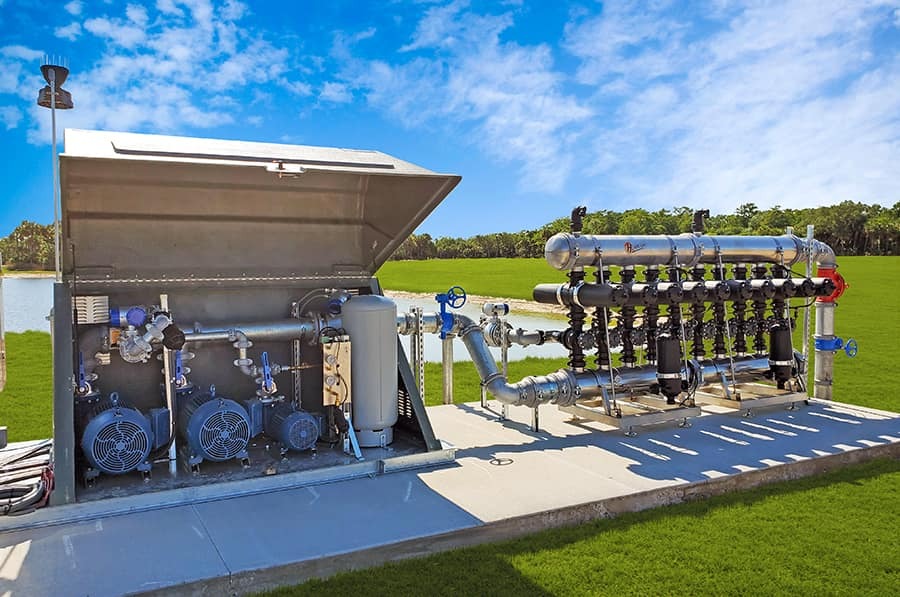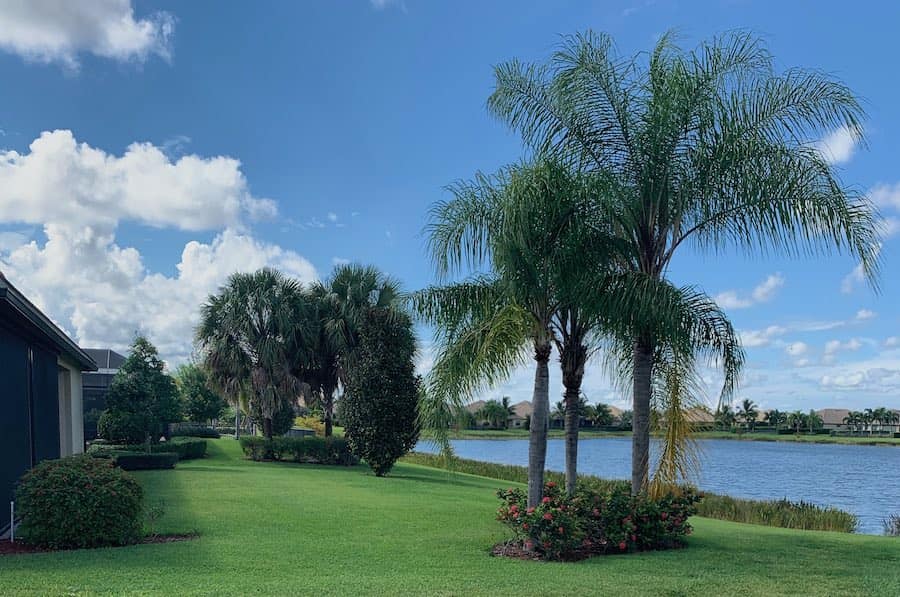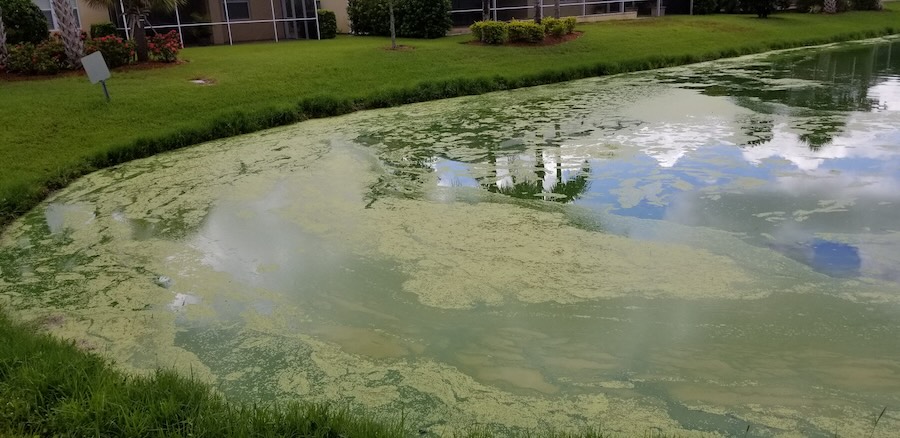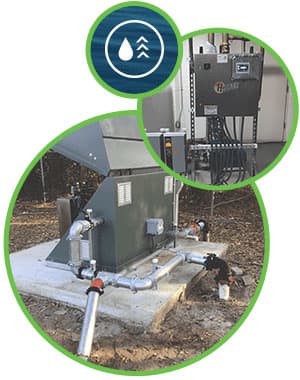
Updated 21 March 2024
If you rely on an irrigation system then you rely on irrigation pumps - these form the foundation of your system. Although many other parts of the system – such as the control panel, sprinkler heads, switches and pipes - are vitally important, the irrigation pump is the basic unit responsible for shifting the water from source to the areas where it needs to be applied.
Here at Hoover we design and install large-scale irrigation systems for places such as golf courses, shopping malls, business parks and residential communities. We’ve written in the past about our expertise in pump station design and installing pump stations capable of delivering exact, responsive and precisely tailored irrigation solutions. Our pump stations are helping customers all over Florida maintain landscapes in optimum condition at the same time as helping to conserve water and reduce the overall irrigation spend.

No matter how sophisticated the tech and the engineering becomes however, the most important component of any irrigation system will always be the irrigation pump. In simple terms, if you choose the wrong pump for your irrigation needs, you’ll be left with a system that can’t deliver sufficient water for your landscape - or one which draws upon much more power and water than is necessary. Even if the irrigation system is able to function with a pump that is less than optimal, the fact that the pump in question is probably operating at the limits of its capacity will increase the frequency of maintenance and repair work on the basis of wear and tear.
In this article we’ll look at some of the pump types available for irrigation systems, as well as explaining which are best suited to particular water sources and what to look for when choosing a pump for your requirements.
A large acreage on a property development requiring irrigation? A sports field? Or a golf course irrigation system? Until you’re completely clear about things such as the amount of water you’ll need to run the system, the distance it will have to travel, the water source you’ll be pumping from and the irrigation methods you’ll be employing, you won’t have a firm idea of the size and type of pump best suited to your needs.
Pump engineering concepts are not learned in a day, but you will benefit from having a rudimentary understanding of them.

One thing to understand when choosing your pump is that the labeling used on pumps purchased off-the-shelf can sometimes be misleading. Most of them will detail the flow rate or gallons per minute (GPM) the pump can shift and the pressure at which the water will be delivered in PSI. As always, what needs to be understood is that these figures represent the optimum levels for both figures in ideal operating circumstances.
Working out the kind of performance any given pump is likely to deliver in reality involves an understanding of a) how far the water will need to be lifted (vertical lift), and b) the pressure it loses while traveling (friction loss) and c) the operating pressure required to do the job at the point of use. These are the challenges a pump needs to overcome to deliver the desired levels of irrigation.
A combination of these three is known as the total dynamic head (TDH). Have this to hand, as well as the gallons per minute (flow rate) you need to apply to the area being irrigated and you’ll be able to check the performance curve provided by the manufacturers of any pump you’re considering buying.
If you’re purchasing an off-the-shelf pump for a large-scale irrigation system, or working with a contractor to put such a system in place, the likelihood is that a pump that's sufficiently powerful to supply your system with water will be described as a ‘high pressure pump’ rather than simply an ‘irrigation pump’. It’s also worth stating that even if your irrigation system is being designed and installed by experts it will pay dividends in the long term to keep yourself as informed as possible about the decisions being made on the type of pump selected and why that choice was made.
In simple terms, the more you know and understand about the irrigation system that's going to drive your project, the more you’ll get out of it in terms of efficiency, return on investment, effective delivery - and a healthy landscape.

There's a reason centrifugal pumps are a popular choice for irrigation; they're extremely versatile, can operate on dry land or under water, and are able to pump large volumes of water against high levels of resistance. The resistance in question might come from the height differential between the source of the water and the irrigation zones or the nature of the system itself, including the complexity and width of the pipes and the material used.
In all cases the principle of a centrifugal pump is the same, and can be explained through the idea of a bucket of water on the end of a rope, being swung around in a circle. As it swings, the centrifugal force of the movement pushes the water against the bottom of the bucket, rather than it spilling out of the top. Now imagine there's a hole in the bottom of the bucket. The water would be forced through the hole at a speed dependent on the amount of centrifugal force being applied through the swing action. Next, think of placing an airtight cover on the bucket. Now a partial vacuum has been created, and if a water source were then connected via an intake pipe, the vacuum created by water leaving the bucket would draw more water in.
Of course, there's a bit more engineering to an actual centrifugal pump! But the principle is as described. In a centrifugal pump, the casing of the pump acts as the body and airtight cover of the bucket, with the hole in the bottom being the outlet and the pipe in the top being the inlet. In the pump the centrifugal force is provided by the spinning of an impeller.
Wikipedia describes an impeller as a "...rotating component of a centrifugal pump that accelerates fluid outward from the center of rotation...". In some cases the centrifugal pump will have more than one impeller and casing, and in these ‘multi-stage’ pumps the pressure of the water increases each time it travels from one to another.
Centrifugal pumps of this kind need to be ‘primed’ before they are turned on. This means that water needs to be present in the inlet and casing and, since the pump can’t suck water in when it is initially full of air, this water will need to be added manually and the pump quickly turned on. In most cases, the pump will contain a valve which ensures that the water is held inside it for future use, and it therefore won’t need to be primed again.
An ‘end-suction centrifugal pump’ will feature a pump mounted on the end of the drive shaft of a motor which, in the case of most modern irrigation systems, will be electrically powered. One of the disadvantages of a centrifugal pump of this kind is that it operates less efficiently if it has to draw water from a source that's lower than the level of the pump – i.e. the pump is mounted on the banks of a river or irrigation lake. In general terms end suction centrifugal pumps of this kind excel at pushing water out but are not so good at sucking water in, and in most cases the manufacturer will provide a maximum height above the surface level of the water source, above which the pump won’t operate.
Other advantages of centrifugal pumps include the fact that they are relatively simple to install and deliver high flow rates, while the range of sizes available makes them suited to all types of irrigation methods, such as drip irrigation, sprinkler systems and pivot irrigation. They're also considered easier to access for repair and service purposes than the submersible alternatives. Disadvantages to take into consideration include limits to the amount of pressure they are able to generate, the fact that they only work effectively via surface pumping or where the lift needed is low, and the requirement for suction and discharge piping to be attached to the pump.
Submersible pumps are another form of centrifugal pump which – as the name suggests – operate underwater. This makes them the ideal choice for irrigation systems that rely on pumping water from an irrigation lake or, in some cases, from wells located deeper underground.
The operation of a submersible pump involves the whole of the unit – motor and pump – being installed underneath the surface of a body of water. In some cases, a submersible pump could be mounted on a structure such as the post of a pier in a lake, although a mounting of this kind isn’t always necessary.
Submersible pumps differ from land-based centrifugal pumps in several respects. The first of these is that, as they are located under water, they don’t need to be primed before first use. The second is that because they don’t need to suck the water up from an irrigation lake, they can operate much more efficiently; the energy being used purely to push the water from the outlet pipe. The operation of the motor under the water means that most submersible pumps are installed within a sleeve which forces some of the water entering the pump over the surface of the motor. This keeps the motor cool and prevents it from burning out.
In other cases, the submersible pump will be attached to a float, with the float itself being anchored to the floor of the irrigation lake. The pump hangs from the float and water is fed out of the lake via a pipe.
When using a submersible pump you should ensure it's located in a position high enough above the bed of the lake to avoid taking in any silt or debris. The use of filters will mitigate or minimize the risk of foreign bodies entering the pump and either impeding its operation or travelling further on to impact the irrigation system as a whole, but better placement in the first place means your filters will do a better job.

In addition to filter systems being in place, the use of a submersible pump serves to highlight the vital nature of maintaining a healthy irrigation lake in the first place. The healthier, cleaner and less compromised the quality of the water is, the more efficiently a submersible pump will operate and the longer the life span is likely to be. Advantages of a submersible pump include the fact that they operate in a more energy efficient manner than land-based centrifugal pumps and are generally quieter (a benefit for locations close to where people live and work), as well as being more efficient in operational terms because they aren't doing the heavy work required to lift the water from source.
We’ve written in the past about the risks posed by lack of maintenance and care of lake water. So often this neglect results in contamination - issues such as the presence of cyanobacteria and bryozoans in the lake water. For this reason, the filter systems of a submersible pump need to be rigorous enough to lower the risk these contaminents and others present.
In some cases, a larger irrigation system might call for the use a turbine pump. A turbine pump consists of a centrifugal pump which is located underwater like a submersible pump - but with the motor mounted above the water, driving the pump via a shaft. They have the potential to provide a highly efficient pumping solution, with the pumps sometimes operating in multiple stages to maximize the water pressure generated.
This potential means turbine pumps are popularly used for irrigation (we've installed many ourselves), especially when the water source is a wet well. However, for many locations, the installation costs of a turbine pump, not to mention the disruption likely to be caused by the presence of a large motor above surface level, are likely to be seen as detrimental to the overall design, particularly in residential settings. In addition to this, the vertical mounting of the shaft can lead to problems with misalignment which causes excess vibration and possible damage to the pump or the motor. For irrigation systems that demand high pressure but a low flow rate, the turbine pump may be the ideal solution, but only if the size of the motor required – and the running costs for that motor – aren't an issue.
In our experience, turbine systems that use a wet well to pull water into a bore can potentially add a lot of cost and complexity to a project, often with very little long-term gain. The average wet well has a certain well-earned notoriety as a source of dirty, stagnant water that's constantly in need of attention and the cause of much damage and degradation of pump equipment. So, while they do have their advantages especially with a deep well source, we recommend always going direct into a lake source if that's an option (if you'd like to read more on the topic, we've discussed the differences between irrigation lake and wet wells in our post Do Irrigation Lakes Offer Benefits Over Wet Wells).
 Booster pumps differ from the other pumps mentioned in as much as they don’t take water from one location – such as a lake – and move it to another. These pumps are placed within an irrigation system to boost the pressure of the water that's already travelling through that system.
Booster pumps differ from the other pumps mentioned in as much as they don’t take water from one location – such as a lake – and move it to another. These pumps are placed within an irrigation system to boost the pressure of the water that's already travelling through that system.
Often, booster pumps are used in municipal applications - lifting water several floors in a high rise but they do have their uses in the irrigation field. For example, your sprinkler system may require pressure of 90 PSI to operate efficiently and maintain an effective spray distance at the sprinkler head. But if the centrifugal pump itself is only generating 60 PSI – perhaps because of resistance caused by the height difference between the source and the irrigation – then a booster pump could be fitted between the centrifugal pump and the irrigation zones in order to lift the PSI to 90.
Actually, a floating pump could refer to any type of pump, provided it is attached to a float. In most cases the pump will be a submersible pump under a float, although other types of pump could be mounted on top of a float. The float itself will be anchored in the water source and a flexible pipe will carry the water to the wider irrigation system. A floating pump can often be a simpler option when using a source like a pond or lake, because it's easier to fit filters which keep debris from infiltrating the pump at close to surface level than it is to filter the intake of a pump located at the bottom of the water where there's likely to be more silt and debris.
Choosing the right pump for your irrigation system means evaluating all aspects of that system - from the source of the water to the amount of land being covered, the number of sprinklers and the budget available – and asking which type of pump will do the most efficient job.
 There’s no right or wrong answer to the question, as the best pump or pumps for a small gated community will be different to that for a large shopping mall or golf course, so the first stage of choosing any pump will always be a careful audit of exactly what level and type of irrigation is needed.
There’s no right or wrong answer to the question, as the best pump or pumps for a small gated community will be different to that for a large shopping mall or golf course, so the first stage of choosing any pump will always be a careful audit of exactly what level and type of irrigation is needed.